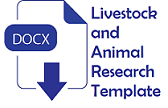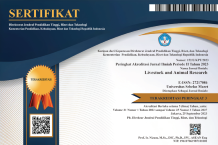Physico-mechanical properties of cattle hide leather for working gloves with flame retardant addition
Abstract
Objective: Indonesian metal casting industry is a labor-oriented industry which involves thermal application in the workplace. Thus, it is essential to protect the workers for any risks during their activity. Leather gloves, as personal protective equipment, need to be manufactured that can prevent the workers from burn injured. The study aimed to analyze the effect of flame retardant addition on finished leather’s physical and mechanical properties for a specific article, i.e. working gloves.
Methods: The research used pickled cattle hides and commercial flame retardant as main materials. The leather chemicals used in the process are those which is commonly used to manufacture working gloves leather article. The treatments involved the addition of commercial flame retardant in fatliquoring (2%, 4%, 6% w/w) and finishing process (100 parts, 200 parts, 300 parts). The effect of flame retardant addition on shrinkage percentage, thickness, rub fastness, tensile strength, and elongation at break, were evaluated. Descriptive analysis is applied to describe the properties of the resulted finished leather.
Results: The result shows that the addition of flame retardant in fatliquoring and finishing process indicates a variation in the leather’s physical-mechanical properties. The leather, manufactured with the addition of 4% (w/w) in fatliquoring, shrunk 7.65±1.42%, had tensile strength value at 520.48±13.79 kg/cm2, good rub fastness at dry and wet basis (5 and 4/5), elongation value at 52.9±4.09%, and thickness 0.87±0.02 mm.
Conclusions: it can be concluded that the use of 4% (w/w) flame retardant in fatliquoring is suggested to be the best formulation to produce working gloves leather.
Keywords
Full Text:
PDFReferences
Dianat, I., C. M. Haslegrave, and A. W. Stedmon. 2012. Methodology for evaluating gloves in relation to the effects on hand performance capabilities: A literature review. Ergonomics. 55:1429-1451. doi:10.1080/00140139.2012.708058.
Batra, S., L. A. Bronkema, M. J. Wang, and R. R. Bishu. 1994. Glove attributes: Can they predict performance? Int. J. Ind. Ergon. 14:201-209. doi:10.1016/0169-8141(94)90096-5.
Novianto, N. D. 2015. Penggunaan alat pelindung diri (APD) pada pekerja pengecoran logam PT. Sinar Semesta (Studi kasus tentang perilaku penggunaan alat pelindung diri (APD) ditinjau dari pengetahuan terhadap potensi bahaya dan resiko kecelakaan kerja pada pekerja pengecoran l. J. Kesehat. Masy. 3:417-428.
Wuyong, C., L. Chunxia, G. Ying, and H. Zan. 2007. Influence of tanning on the flammability of leather. J. Soc. Leather Technol. Chem. 91:159-161.
Zan, H., L. Lixin, L. Yinsheng, L. Yunzhou, and C. Wuyong. 2005. Influence of retanning on the flammability of leather. China Leather. 34:1-4.
Huang, Z., L. Lixin, W. Chen, and H. Gui. 2006. Influence of fatliquoring on flammability of leather. J. Soc. Leather Technol. Chem. 90:155-158.
Ying G, Wuyong C, Jiping C, and Haibin G. 2007. Influence of finishing on the flammability of leather. J. Soc. Leather Technol. Chem., 91 (5), 208–211.
Mustakim, Widati AS, Al-Awwaly KU, and Umaya L. 2017. Pengaruh presentase kuning telur itik dan asam formiat dalam proses peminyakan terhadap kekuatan fisik kulit ayam pedaging sama khrom. J. Ilmu dan Teknol. Has. Ternak, 12 (1), 29–38. doi:10.21776/ub.jitek.2017.012.01.5.
Wiryodiningrat, S., R. S. Murti, and I. F. Pahlawan. 2012. Pembuatan kulit jok ramah lingkungan untuk otomotif. Maj. Kulit, Karet dan Plast. 28:9-17. doi:10.20543/mkkp.v28i1.200.
Griyanitasari, G., E. Kasmudjiastuti E, and B. Pidhatika. 2017. Pengaruh variasi pigmen untuk lapisan dasar (base coat) pada proses finishing terhadap sifat fisik kulit sapi. Bul. Peternak. 41:307-318. doi:10.21059/buletinpeternak.v41i3.16649.
BSN. 2009. SNI 0234:2009 Kulit bagian atas alas kaki - Kulit boks. Badan Standardisasi Nasional, Jakarta.
BSN. 2005. SNI 06-7128-2005 Cara uji pengukuran tebal kulit jadi. Badan Standardisasi Nasional, Jakarta.
BSN. 1989. SNI 06-0996-1989 Cara uji ketahanan gosok cat tutup untuk kulit jadi dengan alat crock meter. Badan Standardisasi Nasional, Jakarta.
BSN. 1992. SNI 06-1795-1990: Cara uji kekuatan tarik dan kemuluran kulit. Badan Standardisasi Nasional, Jakarta.
Jatmiko W, Santoso HB, Purbarani SC, Syulistyo AR, Purnomo DMJ, Firmansyah D, Yusuf M, dan Laili NA. (2015). Panduan penulisan artikel ilmiah. UI Press, Jakarta.
BSN. 1989. SNI 06-0485-1989 Kulit sarung tangan samak krom dari kulit sapi untuk kerja berat. Badan Standardisasi Nasional, Jakarta.
Zan, H., L. Lixin, W. Yinghong, L. Yunzhou, and C. Wuyong. 2005. Performance of flame retardants on leather. J. Soc. Leather Technol. Chem. 89:225-231.
Shabbir, M., S. U. Islam, M. N. Bukhari, L. J. Rather, M. A. Khan, and F. Mohammad. 2017. Application of Terminalia chebula natural dye on wool fiber - Evaluation of color and fastness properties. Text. Cloth. Sustain. 2:1-9. doi:10.1186/s40689-016-0011-8.
Onem, E., A. Yorgancioglu, H. A. Karavana, O. and Yilmaz. 2017. Comparison of different tanning agents on the stabilization of collagen via differential scanning calorimetry. J. Therm. Anal. Calorim. 129:615-622. doi:10.1007/s10973-017-6175-x.
Wu, C., W. Zhang, X. Liao, Y. Zeng, and B. Shi. 2014. Transposition of chrome tanning in leather making. J. Am. Leather Chem. Assoc. 109:176-183.
Pahlawan, I. F. and E. Kasmudjiastuti. 2012. Pengaruh jumlah minyak terhadap sifat fisis kulit ikan nila (Oreochromis niloticus) untuk bagian atas sepatu. Maj. Kulit, Karet, dan Plast., 2:105-111. doi:10.20543/mkkp.v28i2.113.
Li, Z., D. Paudecerf, and J. Yang. 2009. Mechanical behaviour of natural cow leather in tension. Acta Mech. Solida Sin. 22:37-44. doi:10.1016/S0894-9166(09)60088-4.
Sanchez-Olivares, G., A. Sanchez-Solis, F. Calderas, L. Medina-Torres, O. Manero, A. Blasio, Di, and J. Alongi. 2014. Sodium montmorillonite effect on the morphology, thermal, flame retardant and mechanical properties of semi-finished leather. Appl. Clay Sci. 102:254-260. doi:10.1016/j.clay.2014.10.007.
John, G. 1996. Possible defects in leather production: Definitions, causes, consequences, remedies and types of leather. 1st ed. Lapertheim, Germany.
Sizeland, K. H., G. Holmes, R. I. Edmonds, N. Kirby, A. Hawley, S. T. Mudie, and R. G. Haverkamp. 2015. Fatliquor effects on collagen fibril orientation and D-spacing in leather during tensile strain. J. Am. Leather Chem. Assoc. 110:355-362.
Refbacks
- There are currently no refbacks.










